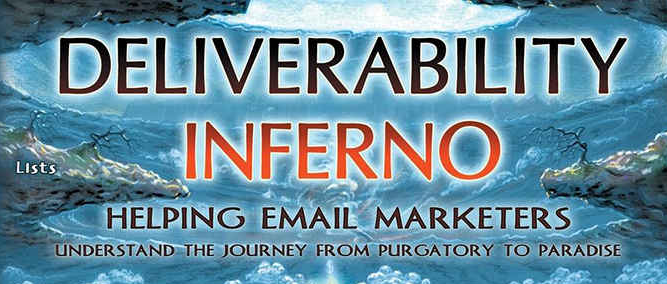Guest Post: Neil Anuskiewicz
In Dante’s Inferno, the poet Virgil guides Dante through the nine circles of hell and purgatory, enabling Dante to learn the lessons he needs to get to Paradiso. Similarly, in Deliverability Inferno, Chris Arrendale, guides the reader on a journey through the nine challenges of email deliverability enabling the reader to learn the lessons needed to get to Paradise (aka the Inbox).
As I read the table of contents, I was immediately struck by the holistic alignment of permission-based email marketing best practices and email deliverability best practices. This hasn’t always been the case.
In 2006, Inbox placement was mostly about avoiding spam trigger words and phrases and keeping spam complaints down. It was too easy to mindlessly send email “blasts” at people, clogging their inboxes, dragging down their productivity, and prompting many people to hope social media would replace email altogether.
The industry responded with a concerted effort to reduce the amount of junk mail making it to the Inbox, making it very difficult to successfully “batch and blast” a lot of emails at people these days.
In addition to making email more pleasant to use, the new system rewards email marketers who follow best practices and learn the lessons offered by the nine challenges.
Email deliverability best practices have finally aligned with email marketing best practices, rewarding those who take pride in their craft. If you’re conscientious enough to read a review of a book on email deliverability, there’s a good chance you already know much of what this book teaches.
Arrendale introduces the concept of sender reputation early in the book, weaving it into each of the nine challenges.
When content scanners are reading through your email, they are looking at every link. If the link has a bad reputation, it will affect your brand’s reputation and deliverability. This may come as a surprise to some people who don’t realize this and operate with affiliates or third parties.
Arrendale also asks Socratic questions meant to get you thinking about deliverability basics, including permission, segmentation, and engagement. He then dives deeper into a discussion of IP addresses and subdomains, emphasizing the importance of protecting your root domain and the IP address that sends your day-to-day email that’s critical to the operation of most businesses. He then returns to the basics, reinforcing the knowledge you need to resist temptation and stay firmly on the path to the inbox.
I doubt many readers will look at a bounce report quite the same way again after reading this book. Arrendale reviews the basics and makes a strong case for monitoring of bounce reports. Bounce reports can warn you of trouble early so you can take action before a small problem becomes a big problem. For example, bounce reports are where you’re likely to see the first evidence that a particular ISP’s rate limiting your emails.
It is vital to regularly identify rate limiting in the bounce logs for precisely that reason: they are often the first sign a sender has that their reputation is poor. If rate limiting bounces are ignored, the reputation may continue to drop, unnoticed, until it is low enough to cause significant deliverability problems and to cause considerable time and effort to repair.
Arrandale explains that much of email deliverability success is about “taking every step possible to avoid being perceived as a spammer in the eyes of the spam filters and your recipients.” One of the most definitive ways you can affect this is by authenticating your emails. Authentication allows mailbox providers to acknowledge the legitimacy of your email sends.
Deliverability Inferno summarizes what you need to know about compliance, starting out with examples of how the actions of partners and affiliates can affect your reputation and even your compliance. There are three laws that email marketers should research and understand thoroughly. The U.S. CAN-SPAM act, The Canada Anti-Spam Law (CASL) and The European Union’s GDPR.
As you approach the end of your journey towards deliverability paradise, it’s time to gain some understanding of email technology. Learning about all the various technologies involved in delivering your email as well as how to get your email delivered to recipients at the different major inbox providers, providing some useful tips on identifying and resolving some common deliverability problems will give a more in-depth understanding into the world of deliverability and the journey to the consumer’s inbox.
In conclusion, I’d recommend this as a good email deliverability primer, though I think even experienced email marketers will likely learn something new.
About Neil Anuskiewicz:
Neil worked as a hostmaster for an ISP and a solutions engineer for an ESP. Now, as a freelancer, Neil solves email deliverability, DNS, security, and other technical problems for clients.


